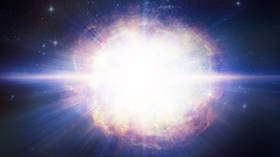Astronomers detect supernova so powerful it was previously thought IMPOSSIBLE

Astronomers have witnessed the brightest, most energetic and most massive supernova ever observed by humanity, in an explosion so powerful it was thought to be impossible. Until now.
The supernova, snappily dubbed SN2016aps, is believed to have resulted from a "pulsational pair-instability" supernova or the merger of two massive but unstable stars, prior to one extraordinarily volatile breakup.
The explosion released 10 times the energy of a normal supernova, outshining the average stellar explosion by a factor of roughly 500. It emitted 10 times more energy than the Sun will release in its entire lifetime in the process.
“Not only is it brighter than any other supernova we’ve ever seen, but it has several properties and features that make it rare in comparison to other explosions of stars in the universe,” explained Edo Berger, Harvard University professor and co-author of new research on the exceptional event.
Also on rt.com Supernovae could be bombarding Earth with COSMIC ‘BULLETS’ travelling at 3,000km a second, scientists warnSN2016aps held onto its hydrogen gas, which is rare enough for stars of this size at this stage of life, leading the researchers to theorize that it was in fact the result of two merging stars.
The researchers first identified the supernova in 2016 using data from the Panoramic Survey Telescopes and Rapid Response System (Pan-STARRS) and spent four years tracking and parsing through troves of data, which revealed the monumental amount of energy released.
"The new star, borne of the merger, was heavy with hydrogen and also high enough in mass to trigger pair instability,” Berger said. Supernovas usually only last for a few months but this one was so big that it has been observed for four years.
Also on rt.com Two stars merging created iconic blue SUPERGIANT supernova in a galaxy next doorThe study theorized that the origin star shed a massive shell of gas, roughly half of the star’s total mass, as it pulsated near the end of its life. The shell fell off at the last second, relatively speaking, a mere few decades before the supernova, as opposed to several thousands of years prior to supernova, as happens normally.
The explosion then ripped through the shell at a speed of about 4,600 kilometers per second, creating the largest-ever explosion of which we are aware.
“Until now it wasn’t clear that explosions this powerful were even possible,” Berger concluded.
The researchers will now use what they have learned from their work on SN2016aps to look for evidence of similar scale events from the first billion years in the history of the universe.
Think your friends would be interested? Share this story!














